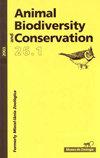相机捕捉到的数据揭示了斯里兰卡马杜鲁奥亚国家公园印度穿山甲的栖息地关联、活动模式和种群密度
IF 1
4区 环境科学与生态学
Q3 BIODIVERSITY CONSERVATION
引用次数: 0
摘要
印度穿山甲(Manis crassicaudata)是一种独居的中型哺乳动物,原产于南亚。在这项研究中,我们使用了2019年1月至2021年1月进行的中哺乳动物调查中记录的相机陷阱数据,以评估斯里兰卡马杜鲁奥亚国家公园(MONP)印度穿山甲的占用率、栖息地关联、人口密度和活动模式。主要栖息于干混交林,占据概率为0.42±0.19。占用模型揭示了该物种与林冠覆盖度高、NDVI指数高、白蚁丘丰富的公园森林生境的相关性。这种穿山甲的活动是高度夜间的,午夜后达到高峰。我们观察到印度穿山甲活动与人类活动有相当大的时空重叠,这可能增加了该物种的狩猎压力。在研究区首次采用随机相遇模型估算了基于占用度和丰度的种群密度(0.73±0.21个体/km2)。这些发现可能有助于保护和管理有关世界上最被贩运的哺乳动物之一——印度穿山甲的生存和重要栖息地的决策。本文章由计算机程序翻译,如有差异,请以英文原文为准。
Camera trap data reveal the habitat associations, activity patterns and population density of Indian pangolin (Manis crassicaudata) in Maduru Oya National Park, Sri Lanka
The Indian pangolin (Manis crassicaudata) is a solitary, medium–sized mammal native to South Asia. In this study we used camera trap data recorded during a meso–mammal survey conducted from January 2019 to January 2021 to assess the occupancy, habitat associations, population density and activity patterns of Indian pangolins in Maduru Oya National Park (MONP), Sri Lanka. The preferred habitat of the species was dry–mixed forest with an occupancy probability of 0.42 ± 0.19. Occupancy modeling revealed the association of the species with the forested habitats of the park with rich canopy cover, high NDVI scores and abundant termite mounds. Activity of this pangolin was highly nocturnal, reaching a peak after midnight. We observed a considerable spatiotemporal overlap in Indian pangolin activity and human activity, possibly increasing hunting pressure on the species. We estimated occupancy and abundance–based population density (0.73 ± 0.21 indiv./km2) using the random encounter model for the first time in the study area. These findings could be useful for conservation and management decisions concerning the survival and vital habitats of one of the most trafficked mammals in the world, the Indian pangolin.
求助全文
通过发布文献求助,成功后即可免费获取论文全文。
去求助
来源期刊

Animal Biodiversity and Conservation
农林科学-动物学
CiteScore
2.00
自引率
0.00%
发文量
21
审稿时长
>12 weeks
期刊介绍:
Animal Biodiversity and Conservation (antes Miscel·lània Zoològica) es una revista interdisciplinar, publicada desde 1958 por el Museu de Ciències Naturals de Barcelona. Incluye artículos de investigación empírica y teórica en todas las áreas de la zoología (sistemática, taxonomía, morfología, biogeografía, ecología, etología, fisiología y genética) procedentes de todas las regiones del mundo. La revista presta especial interés a los estudios que planteen un problema nuevo o introduzcan un tema nuevo, con hipòtesis y prediccions claras, y a los trabajos que de una manera u otra tengan relevancia en la biología de la conservación. No se publicaran artículos puramente descriptivos, o artículos faunísticos o corológicos en los que se describa la distribución en el espacio o en el tiempo de los organismes zoológicos.
 求助内容:
求助内容: 应助结果提醒方式:
应助结果提醒方式:


